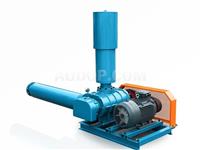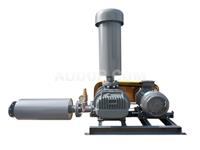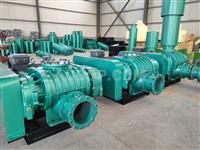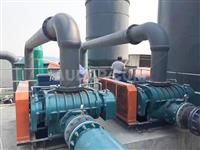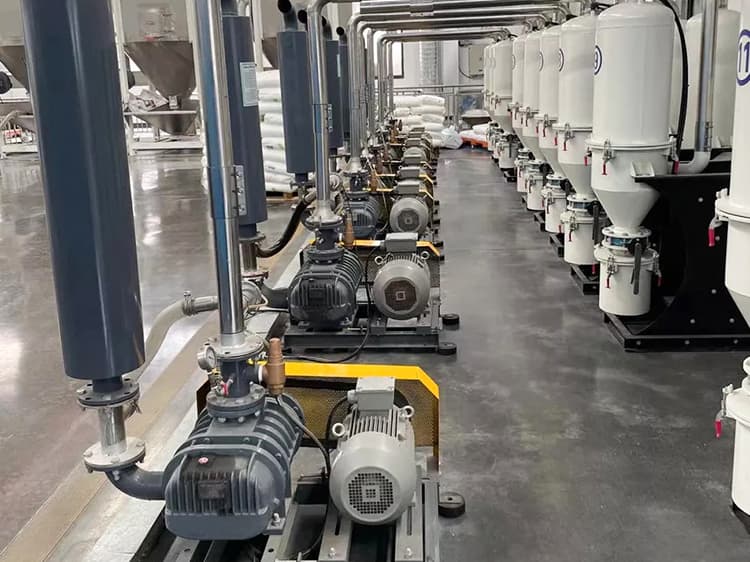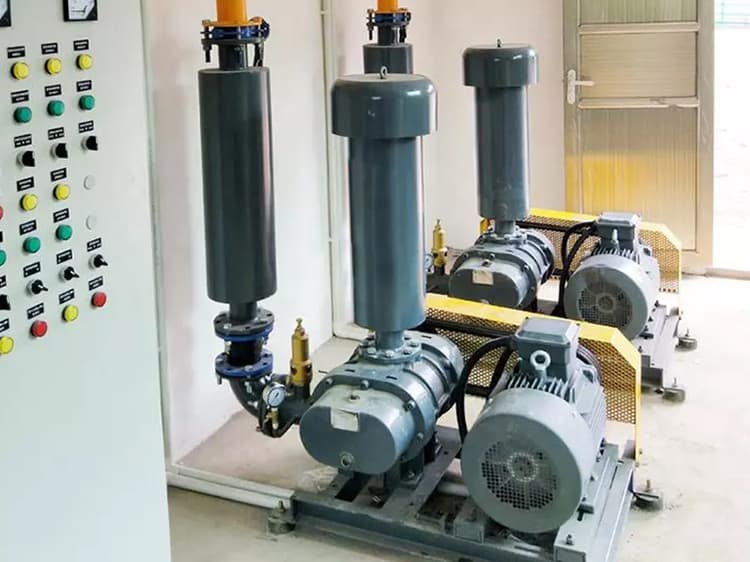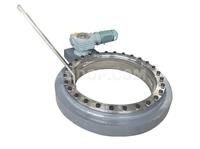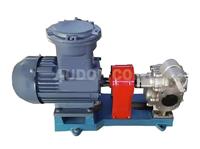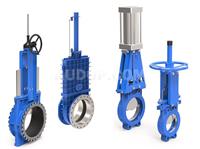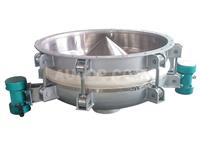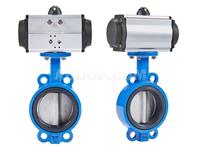Roots Blower
- It has the characteristic of forced transportation. Under the condition of a certain rotating speed, the flow rate is basically unchanged. Even in the small flow rate area, surge will not occur, and it has stable working characteristics.
- As a rotary machine, it has no reciprocating mechanism, no air valve, few wearing parts and a long service life.
- It inhales and exhausts air many times in one operation cycle. Compared with the piston compressor, the air flow speed is uniform and there is no air storage tank.
- There is a certain gap between the moving parts and the static parts, and no lubricating oil is needed in the chamber, which ensures that the transported gas is oil-free and no oil-gas separation device is required.
- There is no internal compression process, and the mechanical efficiency is high.
Overview
Roots blower is a positive displacement blower, mainly composed of impellers, rotating shafts, gears, bearings and other components.Roots blower uses two or three blade rotors to perform relative motion in the cylinder for compressing and transporting gas.Roots blower has the characteristics of simple structure, convenient manufacturing, oil-free medium during transportation, easy maintenance, long service life and low vibration of the whole machine. It is widely used in metallurgy, chemical industry, chemical fertilizer, petrochemical, instrumentation and building materials industries. It can also be used for oxygenation in aquaculture, aeration in sewage treatment and cement transportation. It is more suitable for gas transmission and pressure boosting systems in low-pressure occasions and can also be used as a vacuum pump, etc.
Roots blower transports gas by relying on the change of the working chamber volume formed when two involute "8"-shaped rotors rotate.Roots blower is the first-choice product for transporting media such as clean air, clean gas, sulfur dioxide and other inert gases, as well as for the special gas industry (gas, natural gas, biogas, carbon dioxide, sulfur dioxide, etc.) and high-pressure working conditions.In view of the above characteristics, it can be widely adapted to the metallurgy, chemical industry, chemical fertilizer, petrochemical, instrumentation and building materials industries.
Working Principle of Roots Blower:
Roots blower is a high-volume blower. It separates the inlet and exhaust ports through a pair of rotors "meshing" (there is a gap between the rotors and they do not contact each other).The rotors move in opposite directions by a pair of synchronous transmission gears, pushing the inhaled gas from the suction port to the exhaust port without internal compression.When the gas reaches the exhaust port, the gas is pressurized due to the backflow of high-pressure gas on the exhaust side, thus completing the gas transportation.The two rotors do not contact each other, and the seal between them is achieved by a strictly controlled gap, so the gas is not contaminated by lubricating oil.
Composition Structure of Roots Blower:
- Roots blower is composed of five main parts: casing, wall plate, impeller, oil tank and muffler.
- Casing: It mainly plays the role of supporting (wall plate, impeller, muffler) and fixing.
- Wall plate: It is mainly used to connect the casing and the impeller, support the rotation of the impeller, and achieve the effect of end face sealing.
- Impeller: It is the rotating part of the Roots blower, which is divided into two-blade and three-blade types. However, due to the many advantages of three-blade impellers such as smaller air outlet pulsation, lower noise and more stable operation compared with two-blade impellers, three-blade Roots blowers have gradually replaced two-blade Roots blowers.
- Oil tank: It is mainly used to store lubricating oil for lubricating gears and bearings.
- Muffler: It is used to reduce the noise generated by air flow pulsation when the Roots blower inhales and exhausts air.
Classification of Roots Blower:
- According to different working methods, Roots blowers can be roughly divided into single-stage and double-stage types. Among them, the blower with only one compression stage is called a single-stage blower, while the blower that connects two single-stage blowers in series and compresses the gas twice continuously is called a double-stage series blower.
- Classified by the number of impeller heads: two-blade Roots blower and three-blade Roots blower.
- Classified by purpose: vertical kiln blower, gasification blower, aeration blower, etc.
- Classified by medium type: air blower, gas blower, hydrogen blower, sulfur dioxide blower, etc.
- Classified by transmission mode: direct-connected blower and belt-connected blower, etc.
- Classified by cooling method: air-cooled blower, water-cooled blower and countercurrent cooling blower, etc.
- Classified by structural form: vertical blower, horizontal blower, vertical shaft blower, compact group blower, etc.
- Classified by sealing form: blowers with various sealing forms such as labyrinth seal, expansion ring seal, packing seal and mechanical seal.
Application of Roots Blower:
As a typical gas pressure boosting and transmission machine, Roots blower has a wide range of applicable characteristics in its specific pressure range.In terms of application, most Roots blowers are used as air blowers, and their applications cover many fields such as building materials, electric power smelting, chemical industry and petrochemical industry, mining, ports, light industry and textiles, post and telecommunications, food and paper making, aquaculture and sewage treatment. When using a sealing device with good air tightness, it can also be used to transport gases other than air, such as hydrogen, oxygen, carbon monoxide, carbon dioxide, hydrogen sulfide, sulfur dioxide, methane, gas, etc. In addition, in some fields such as medicine, food chemical industry and petrochemical industry, Roots blowers are usually used as air source machines for various low-pressure pneumatic conveying systems.
Chemical industry: Roots blowers are widely used in the chemical industry. According to different working conditions, they are widely applied, such as transporting chemical raw materials, transporting reaction gases, aeration and stirring, etc.
Sewage treatment industry: In the sewage treatment industry, since the sewage tank needs to be filled with oxygen for microbial oxidation and decomposition, Roots blowers can provide a fixed amount of oxygen according to different water depths and treated water tons to promote microbial oxidation and decomposition.
Operating Conditions of Roots Blower:
- The inlet temperature of the conveyor medium generally cannot exceed 40 degree centigrade.
- The content of particles in the medium cannot exceed 100mg/m³, and the size of the particles cannot exceed half of the working interval.
- During operation, the bearing temperature cannot exceed 95 degree centigrade, and the lubricating oil temperature cannot exceed 65 degree centigrade.
- The working pressure cannot be higher than the pressure boosting range specified on the nameplate.
- The gaps between the impeller and the casing, the impeller and the side plate, and between the impellers of the Roots blower have been adjusted in the factory, and this gap must be ensured during reassembly.
- When the Roots blower is running, the oil level in the main oil tank and the oil tank should be between the two red lines of the oil level gauge.
- Check whether there are any unfixed parts at the inlet and outlet connection parts and whether the supporting points of the pipeline are complete. For blowers and vacuum pumps that require cooling water, it is necessary to ensure that the installation of cooling water meets the requirements.
Maintenance of Vertical Roots Blower:
- Always keep the surface of the machine and its surrounding area clean, free of dust and oil dirt. Frequently check the tightness of the connecting bolts in various parts and tighten the loose nuts.
- Frequently check whether the bearing temperature is overheated. The allowable temperature rise and maximum temperature of the Roots blower bearing and gearbox should comply with the provisions in the following table.
- Check the oil level gauge of the gearbox and reducer. The lubricating oil should be added to the specified scale line, not too much or too little. And frequently check whether the oil seal device has air leakage.
- Check whether the lubrication system of the machine is normal, select the correct lubricating grease (oil) to add, and regularly refuel or change the oil according to the cycle specified in the lubrication system.
- For blowers with gear oil pumps, check the operation status of the oil pump and whether the oil circuit is blocked.
- Frequently listen to the operation status inside the blower to check for friction, overheating and abnormal operation sounds.
- Make records according to the specified time in each shift. The records include the rated current, gas outlet temperature, outlet air pressure, outlet air volume of the blower during operation, etc.
- Establish various maintenance systems, such as the patrol inspection system.
Technical Parameters
Technical Parameters
| Model | pressure(kpa) | Quantity of flow(m³/min) | Power(kw) |
| ADP-50 | 9.8-70 | 0.5-2 | 0.75-4 |
| ADP-65 | 9.8-70 | 1-2.5 | 0.75-5.5 |
| ADP-80 | 9.8-100 | 2.5-4 | 2.2-7.5 |
| ADP-100 | 9.8-100 | 3-6 | 3-11 |
| ADP-125 | 9.8-100 | 5-9.5 | 5.5-18.5 |
| ADP-150 | 9.8-100 | 10-22 | 7.5-37 |
| ADP-175 | 9.8-50 | 19.65-34 | 11-55 |
| ADP-200 | 9.8-100 | 27-56 | 15-110 |
| ADP-250 | 9.8-100 | 60-90 | 30-160 |
| ADP-300 | 9.8-100 | 90-130 | 37-200 |
| ADP-350 | 9.8-100 | 80-116.82 | 55-160 |
Your requirements are the basis for our development and a daily challenge to bring to fruition, please do not hesitate to inquiry us.
Scraper Arch Breaker
- High-Quality Material Guarantee: The main body is made of SUS304 stainless steel, which has stable physical properties. It is not only corrosion-resistant and wear-resistant but also meets the hygiene level requirements of the food and pharmaceutical industries, avoiding contamination when materials come into contact with the equipment. SUS304 stainless steel scraper arch breakers are safe for food-grade applications.
- Simple Structural Design: The overall structure has no complex redundant parts and adopts a "bolt-free" assembly process, reducing gaps for material accumulation and cleaning blind spots. During daily maintenance, there is no need to disassemble complex components; only the scraper wear condition and gear lubrication status need to be checked, which greatly reduces maintenance costs and downtime. Low-maintenance scraper arch breakers save production costs for factories.
- Long Service Life: The core transmission components (gears) adopt precision machining technology, and combined with the wear-resistant treatment of the scraper, mechanical loss during operation is reduced. At the same time, compared with chain transmission, the gear transmission method avoids the risk of chain loosening and breaking, and the average service life of the equipment is more than 30% longer than that of traditional discharging equipment. Long-life scraper arch breakers reduce equipment replacement frequency for manufacturers.
- Significant Arch-Breaking and Wall-Cleaning Effect: The design of the scraper making circular motion along the silo wall can directly act on the retained materials on the side walls and bottom of the silo. It not only solves the "bridging" and "hollowing" problems but also cleans the materials attached to the silo wall, avoiding caking and deterioration caused by long-term material retention and improving material utilization rate. Scraper arch breakers with excellent wall-cleaning function enhance production efficiency.
- Alleviating Material Segregation: For mixed materials with uneven particle sizes, traditional discharging methods are prone to "segregation" (large particles concentrate at the bottom and small particles concentrate at the top) due to different particle settlement speeds, which affects subsequent production quality. The scraper arch breaker keeps the materials in a mixed state during the falling process through the uniform stirring and pushing of the scraper, effectively alleviating the segregation problem. Scraper arch breakers prevent material segregation for consistent product quality.
- Quiet Operation Experience: The gear transmission link adopts a high-precision meshing design, and combined with the lubrication treatment of bearings, the noise during operation is controlled below 60 decibels (equivalent to the volume of daily conversation), avoiding the harsh noise of traditional discharging equipment during operation and improving the workshop working environment. Quiet scraper arch breakers create a comfortable working environment for production line engineers.
- Wide Hopper Angle Adaptability: It can adapt to hopper angles within 45°. Whether it is a vertical silo or an inclined silo, accurate connection can be achieved by adjusting the installation angle, without the need for large-scale modification of the existing silo structure. Scraper arch breakers with flexible hopper angle adaptation fit various silo types.
- Rich Specifications and Customization Options: Standard caliber specifications from φ40 to φ500 are provided, covering different needs from small laboratory equipment to large-scale industrial production lines. For large-caliber needs beyond the standard caliber (such as above φ500), exclusive equipment can be customized through technical consultation according to the customer's silo size and material characteristics, ensuring seamless connection with the existing production system. Customizable scraper arch breakers meet diverse industrial needs for purchasers.
- Expandable Blade Design: It supports the installation of multiple scraper blades (the specific number is determined according to material fluidity and discharging volume). The more blades there are, the higher the discharging efficiency and the more uniform the material stirring, which can be flexibly adjusted according to the actual production rhythm. Expandable blade scraper arch breakers optimize discharging efficiency for different production beats.
KCB Series Gear Pump
- KCB Series Gear Pump is mainly composed of gears, shafts, pump body, relief valve and shaft end seal. The gears undergo heat treatment to achieve high hardness and strength, and are installed in replaceable shaft sleeves together with the shafts for operation. The lubrication of all parts in the KCB Series Gear Pump is automatically achieved by using the output medium when the pump is working.
- The pump is designed with reasonable oil discharge and oil return grooves, which reduce the torque force borne by the gears during operation. As a result, the bearing load is small, wear is minimal, and the KCB gear oil pump has high efficiency.
- KCB Gear Pump is equipped with a relief valve for overload protection. The full return pressure of the relief valve is 1.5 times the rated discharge pressure of the pump. The KCB gear oil pump can also be adjusted separately according to actual needs within the allowable discharge pressure range. However, it should be noted that this relief valve cannot work as a pressure reducing valve for a long time; if necessary, a separate pressure reducing valve can be installed on the pipeline. When viewing the pump from the extended end of the main shaft, the rotation direction is clockwise.
Knife Gate Valve
- Ultra-short structural length saves materials and greatly reduces the overall weight of the pipeline system matched with the knife gate valve.
- It occupies small effective space, effectively supports pipeline strength, and reduces the possibility of pipeline vibration when used with the knife gate valve.
- The gate plate of the knife gate valve is made of austenitic stainless steel, which greatly improves corrosion resistance and effectively prevents sealing leakage caused by gate plate corrosion.
- The upper sealing packing of the knife gate valve adopts flexible PTFE, ensuring reliable sealing and easy, flexible operation.
- The gate plate of the knife gate valve has a knife function, which can effectively cut off various impurities in the medium.
Bin Bottom Vibratory Discharger
- Low power consumption, high efficiency and obvious effect.
- The discharge hopper is integrally stamped, with good rigidity and smooth inner wall. The built-in tapered discharge plate protrudes upward to ensure no material residue in the discharger.
- The vibration force and amplitude can be easily adjusted.
- The fixing bolts of the discharge plate are assembled from top to bottom, which improves safety.
- Low noise generated by vibration, meeting environmental protection requirements.
- Safe and reliable to use, with safety protection devices.
- Simple and novel equipment structure, convenient installation and low maintenance rate.
Pneumatic Butterfly Valve
- Fast Response: Pneumatic butterfly valves have a fast opening and closing speed, which can quickly respond to control commands. They are suitable for occasions that require rapid fluid regulation, improving the responsiveness of industrial control systems.
- Simple Structure: Pneumatic butterfly valves have a simple design structure, small size, and light weight. They are suitable for use in narrow spaces, reducing installation space requirements for industrial pipelines.
- Low Cost: Compared with other types of valves, pneumatic butterfly valves have lower manufacturing costs, making them suitable for large-scale applications. This cost advantage helps enterprises reduce equipment investment.
- Easy Maintenance: Due to their simple structure, pneumatic butterfly valves are relatively easy to maintain, reducing production downtime. This helps improve the overall operational efficiency of industrial production lines.
- Precise Flow Regulation: The opening degree of pneumatic butterfly valves can be adjusted through air pressure, realizing precise regulation of flow rate. This feature meets the strict flow control needs of various industrial processes.

